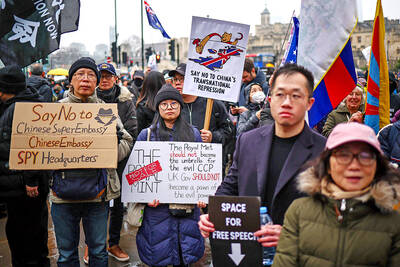A massive ice block broke from a glacier and crashed into a lake in the Peruvian Andes, unleashing a 23m tsunami and sending muddy torrents through nearby towns, killing at least one person.
The chunk of ice, estimated at the size of four soccer fields, detached from the Hualcan glacier near Carhuaz, about 300km north of the capital, Lima, on Sunday.
It plunged into a lagoon known as lake 513, triggering a tsunami that breached 23m-high levees and damaged Carhuaz and other villages, authorities said.
The Indeci civil defense institute said 50 homes and a water processing plant serving 60,000 residents were wrecked. Trout fishermen initially presumed dead survived, leaving one confirmed death.
Authorities evacuated mountain valley settlements fearing that the ice block — measuring 500m by 200m — could be followed by more ruptures as the glacier melts.
Cesar Alvarez, governor of Ancash region, which includes the affected area, blamed climate change.
“Because of global warming the glaciers are going to detach and fall on these overflowing lakes. This is what happened,” he told Peru’s Canal N cable news channel.
Two people were injured when they saw the torrent of water, panicked in their car and crashed.
The number of casualties could have been much greater had the lake level been higher when the ice block fell.
“This slide into the lake generated a tsunami wave, which breached the lake’s levees, which are 23m high — meaning the wave was 23m high,” said Patricio Vaderrama, an expert on glaciers at Peru’s Institute of Mine Engineers.
It was the latest evidence that glaciers are vanishing from Peru, which has 70 percent of the world’s tropical icefields. They have retreated by 22 percent since 1975, according to a World Bank report, and warmer temperatures are expected to erase them entirely within 20 years.

Thousands gathered across New Zealand yesterday to celebrate the signing of the country’s founding document and some called for an end to government policies that critics say erode the rights promised to the indigenous Maori population. As the sun rose on the dawn service at Waitangi where the Treaty of Waitangi was first signed between the British Crown and Maori chiefs in 1840, some community leaders called on the government to honor promises made 185 years ago. The call was repeated at peaceful rallies that drew several hundred people later in the day. “This government is attacking tangata whenua [indigenous people] on all

RIGHTS FEARS: A protester said Beijing would use the embassy to catch and send Hong Kongers to China, while a lawmaker said Chinese agents had threatened Britons Hundreds of demonstrators on Saturday protested at a site earmarked for Beijing’s controversial new embassy in London over human rights and security concerns. The new embassy — if approved by the British government — would be the “biggest Chinese embassy in Europe,” one lawmaker said earlier. Protester Iona Boswell, a 40-year-old social worker, said there was “no need for a mega embassy here” and that she believed it would be used to facilitate the “harassment of dissidents.” China has for several years been trying to relocate its embassy, currently in the British capital’s upmarket Marylebone district, to the sprawling historic site in the

A deluge of disinformation about a virus called hMPV is stoking anti-China sentiment across Asia and spurring unfounded concerns of renewed lockdowns, despite experts dismissing comparisons with the COVID-19 pandemic five years ago. Agence France-Presse’s fact-checkers have debunked a slew of social media posts about the usually non-fatal respiratory disease human metapneumovirus after cases rose in China. Many of these posts claimed that people were dying and that a national emergency had been declared. Garnering tens of thousands of views, some posts recycled old footage from China’s draconian lockdowns during the COVID-19 pandemic, which originated in the country in late

BACK TO BATTLE: North Korean soldiers have returned to the front lines in Russia’s Kursk region after earlier reports that Moscow had withdrawn them following heavy losses Ukrainian President Volodymyr Zelenskiy on Friday pored over a once-classified map of vast deposits of rare earths and other critical minerals as part of a push to appeal to US President Donald Trump’s penchant for a deal. The US president, whose administration is pressing for a rapid end to Ukraine’s war with Russia, on Monday said he wanted Ukraine to supply the US with rare earths and other minerals in return for financially supporting its war effort. “If we are talking about a deal, then let’s do a deal, we are only for it,” Zelenskiy said, emphasizing Ukraine’s need for security guarantees